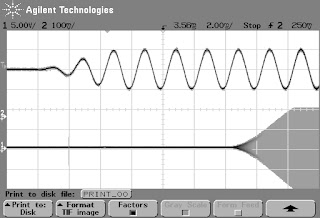For most bands, the image can be suppressed if the input bandpass filter is tightened to have a narrower passband and better out-of-band rejection. But the 10 m/12 m bandpass filter cannot be tightened much before the 10 m bandwidth becomes smaller than the width of the 10 m amateur band. For instance satellite operation could suffer if the bandwidth was made that small. In this case a trap tuned to the undesired image can give the extra suppression needed. A series tuned L-C network from the junction of C47 and C48 to ground can do the trick in the same way that C104 and RFC7 today traps the IF frequency.
I made a trap from a 1 mH inductor in series with 100 pF in parallel with a small 20 pF trimmer capacitor (1 mH and 111 pF resonate at 15110 kHz). I should add that the trap does not affect any other band than 12/10 m since the junction of C47 and C48 is shorted to ground for all the other bands. The improvement in image rejection was 11 dB when I made the inductor from 18 turns of 0.40 mm (26 AWG) on a T37-6 toroid. The capacitance has to be tuned exactly for maximum rejection, but since the 12 m band is so narrow it should cover the whole band.
 |
| Click image for better resolution |
The main source of image interference at my location near Oslo, Norway (60 N, 10 E) is at about 24911 kHz (15031 kHz station). The trap decreased the level from lighting up 4 LED segments on the indicator to 2 segments. This was measured in the 0.70 kHz CW setting. Another image is at 24932 kHz. The images are easy to identify in that their carrier beat tones are reversed compared to the real carriers. Both images were also heard by Dave Johnson, G4AON, who first reported the 12 m image problem of the K2.
A longer pdf-document, "Trap for increasing 12 m image rejection of the Elecraft K2", can be downloaded.





No comments:
Post a Comment